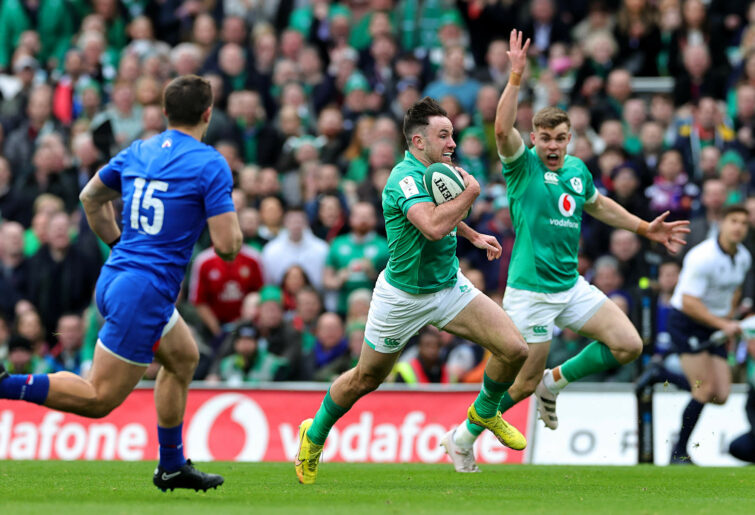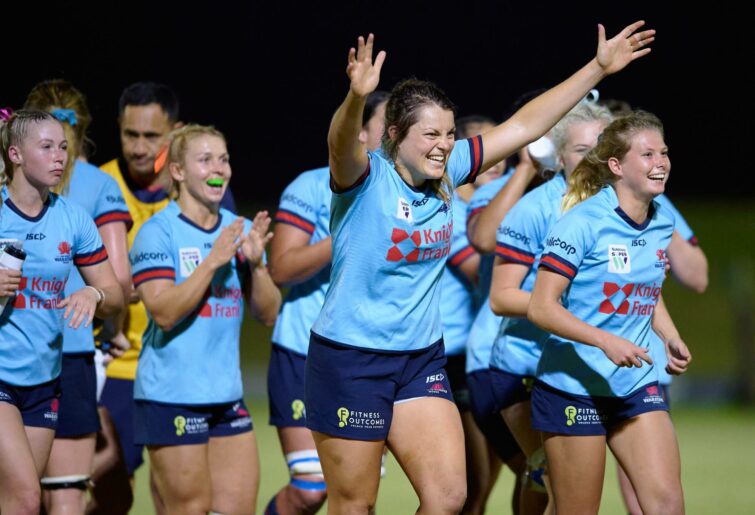It’s been a tough off-season for musicians, with Jeff Beck, David Crosby, Tom Verlaine, Christine McVie, Anita Pointer, and Terry Hall of The Specials all checking out recently. They were joined this week by songwriter Burt Bacharach, whose list of credits almost defies belief.
Personal favourites include the string of 1960s hits that set Dionne Warwick on the path to stardom, Aretha Franklin’s version of ‘Say a Little Prayer’, and Bacharach’s 1998 collaboration with Elvis Costello, ‘Painted From Memory’.
Another notable Bacharach triumph was the 1986 No.1 Billboard Top 100 hit ‘On My Own’, a smooth duet by Patti LaBelle and Michael McDonald.
On my own is where Ireland finds itself, at the top of the world rugby tree, after impressively disposing of France 32-19 in Dublin. This was a Test match of high quality and high intensity, befitting of the world’s two top-ranked nations, seeking both the Six Nations title and pole position ahead of this year’s World Cup.
The match started with an Australian flavour, the local TV commentary team amusingly butchering the pronunciation of ‘Wollongong’, before Hugo Keenan sliced through on an inside play, straight out of the Brumbies’ James Slipper/Tom Banks playbook.

(Photo by David Rogers/Getty Images)
A pulsating first half was notable for France showing a propensity – unusual under Fabien Galthie – to play a lot more ball-in-hand rugby, behind the advantage line, which was aimed at disturbing the structure of Ireland’s defence.
It looked ugly, at least until, all of a sudden, it worked; Damian Penaud streaking away on the diagonal for a thrilling try.
There were other special moments, none better that Antoine Dupont, in the 37th minute, simply refusing to allow Mack Hansen to score. But, unfortunately for France, the good stuff increasingly belonged to the home side, as they built on their 22-16 half-time lead.

Mack Hansen of Ireland is tackled by Antoine Dupont of France during the Six Nations Rugby match between Ireland and France at Aviva Stadium on February 11, 2023 in Dublin, Ireland. (Photo by David Rogers/Getty I
A feature was Ireland’s mastery of the combination rush and drift defence; yes there were first up tackles missed, but mostly, there were green shirts filling all of the important spaces. Ireland had the better kicking game too; fullback Thomas Ramos consistently losing out in the kicking duel to multiple Irish exponents, including Keenan, Johnny Sexton and James Lowe.
Lowe was at the centre of the game’s biggest controversy; spectacularly diving and planting the ball in the left-hand corner, favoured by referee Wayne Barnes’ on-field try indication. The verdict upstairs was that there was insufficient evidence to overturn, although later replays – not seen by Barnes – showed that there was.
It was no surprise to find the pace drop off in the second half, although there can be no doubt that the tempo of the match favoured Ireland, who have become masters at playing on their terms.
Also impressive is their depth. Sexton, Dan Sheehan, Josh Van der Flier and the irrepressible Calen Doris are star turns, but Ireland’s second unit never skipped a beat; testament to both the quality of player and total alignment to the playing system.

(Photo By Brendan Moran/Sportsfile via Getty Images)
By contrast, Scotland’s 35-7 win over Wales was less memorable; no fault of Scotland, whose grand slam hopes remain alive.
Wales, however, look to be in a real hole, lacking ball-running presence up front, and ideas at the back. Not a week goes by without Australia’s World Cup draw looking more and more blessed.
New Wallabies coach Eddie Jones was on hand in Narrabri as Australia’s season began to take shape, four franchises having their final serious hitouts before Super Rugby kicks off in under a fortnight.
Odd man out, the Western Force, complete their pre-season this Thursday in Brisbane, against the Fijian Drua.
For the record, both matches delivered similar scorelines; the Waratahs edging the Reds 33-32, and the Brumbies the Rebels, 35-33.
It’s easy to imagine all four camps coming away reasonably happy, with some nice tries scored across the board, and enough defensive work-ons to keep things sharp and focused over the next few days.
All suffered injuries, but these came in ones and twos, not high multiples. Perhaps the worst was a knee injury to Rebels centre Ray Nu’u. Largely unheralded, Nu’u is highly rated by the Rebels and will be an important loss if scans confirm a serious injury. On the positive side, Reece Hodge played strongly in his place at 12, and enters this season in the best physical shape he has been for a few years.
For the Brumbies, promising lock Tom Hooper suffered a potentially serious foot injury, while in the other match, the Waratahs’ Ned Hanigan hobbled off with a knee injury and the Reds’ Ryan Smith fell awkwardly on a shoulder.
Injuries are a fact of life for all franchises, but with not a lot separating the Australian sides this year, almost certainly, fates will be determined by how many of their first 23 players each franchise can keep on the pitch.
Of the players on the comeback trail, much interest centred on new Waratahs loose forward Lachlan Ferrigno. Whatever moves are made in the future to re-focus rugby as a contact game as opposed to a collision game, for now there seems no let-up in the race for players like Swinton to bulk up even further.
Typically for a trial, both the Waratahs and Reds suffered a lack of combination at lineout, and inaccuracy at the attacking breakdown. There was plenty of kicking – including for goal – with both teams keen to simulate match conditions.
There was also a peek inside the Waratahs conundrum at flyhalf, with Tane Edmed given the starting role, with Wallabies flyhalf Ben Donaldson posted at fullback. Donaldson was tidy, and put his boot to good use, but I’m not sure he appeals as having the speed and agility to break open a game from the back. One thing we know about Super Rugby is that all sides need creative playmakers to maximise any broken play opportunities.
Perhaps their point of difference will come from well-travelled winger Nemani Nadolo – another hulk of a man – who crashed over late for the match winning try/no try.
Here was an early-season reminder for all those who detest TMO interventions and who yearn for the good old days when referees made decisions and everyone accepted it and got on with the game.
With referee Nic Berry unsighted and no TMO in use for a trial match, Nadolo dropping the ball was of no consequence. But just imagine the same thing happening in a live match with ladder points up for grabs…
In emerging player news, Waratahs winger Max Jorgensen (18) scored a delightful try while Reds flyhalf Tom Lynagh (19) looked highly assured. Both will need to overcome the weight of expectation that is part and parcel of being a young Australian rugby talent, but – at the risk of adding to that – both look well capable of managing it.
Also well-managed was the announcement on Saturday, that Australia’s leading women’s players will, for the first time, move onto part-time contracts which will see the top echelon earn up to $55,000 this year.
Included are minimum payments for all Super W players; amounts a long way south of what is offered to England and New Zealand’s best players, not to mention the NRLW, but nevertheless, it is a significant and overdue step in the right direction.

Grace Hamilton of the Waratahs celebrates victory with team mates during the Super W Semi Final match between the NSW Waratahs and the Queensland Reds. (Photo by Brett Hemmings/Getty Images)
Rugby Australia suffered the frustration of watching the higher-powered nations dominate last year’s Women’s World Cup, knowing that the difference was less about talent than it was about time and money.
That financial disparity still exists, but with Rugby Australia’s financial position improving, and private equity investment looming, this is a step along the path towards full-time Wallaroos by 2025, and hopefully, a decent crack at a home World Cup in 2029.
Perhaps the only downside was the quid pro quo for favourable publicity being the need to suffer through ingratiating politicians attaching themselves to the announcement; federal sports minister Annika Wells perceptively calling this a “truly exciting moment for rugby fans and participants”.
Meanwhile, Prime Minister Anthony Albanese, in between happy snaps with Eddie, congratulated “Rugby Australia and all the players and trailblazers who negotiated, organised, sacrificed and worked together to progress the professionalisation of the women’s game.”
Note that yesterday, Rugby Australia confirmed that all of the new funding announced is to come from them. If so, what was the government doing anywhere near this?
Yes, pomp and theatre are important. But if you cringed and a wee bit of vomit backed up in your throat, do not be embarrassed. Unlike Ireland, sitting atop rugby’s tree, you are not ‘on your own’.
































































































